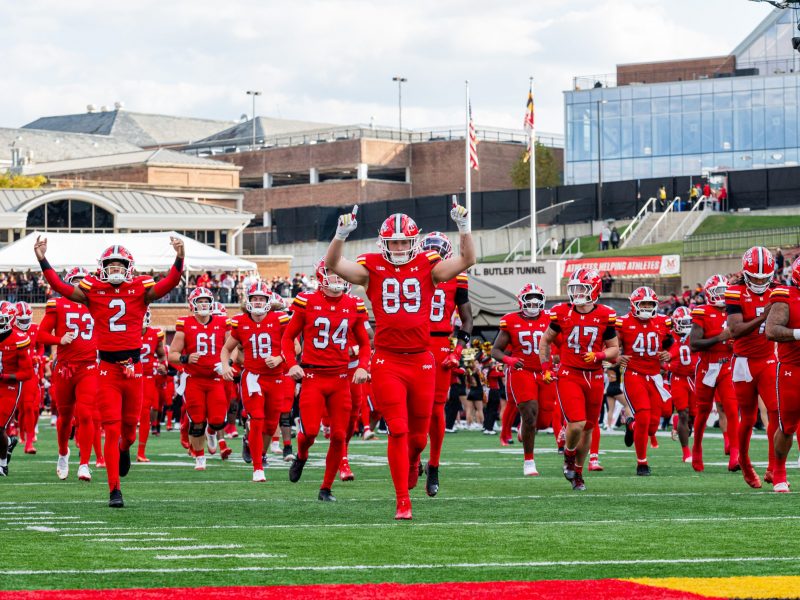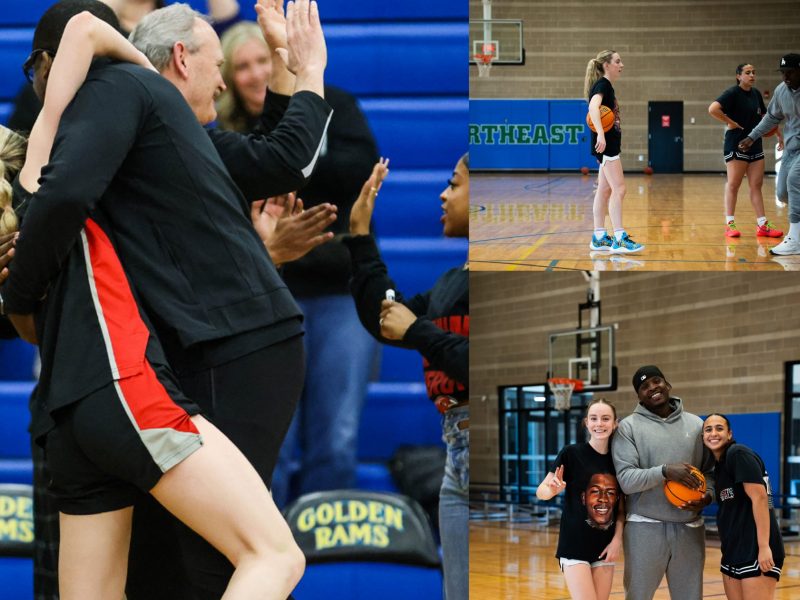The memorial service was scheduled to begin in 10 minutes, but only 50 faculty members and students had gathered on McKeldin Mall. That quickly changed.
In a matter of minutes, a sea of red, white and blue had assembled. More than 10,000 people had come in hopes of finding answers, support or — at the very least — solace. Many were draped in American flags and wore pins over their hearts. All of them held a single flower to be placed on the Omicron Delta Kappa Fountain, a small tribute to the almost 3,000 Americans who had died the day before.
One by one, students from all backgrounds stepped up to the podium to recite the phrase “May peace prevail on Earth” in different languages.
It was September 12, 2001.
24 hours earlier
7:46 a.m. The sun rises over a quiet campus.
Linda Clement, the newly appointed vice president for student affairs, had just begun a meeting with a group of trustees.
University pastor Rev. Elizabeth Platz was driving to work, half-listening to the pleasant background noise of her radio.
Former university President Dan Mote was in his office, early in the fall 2001 semester, gearing up for another September day.
8:46 a.m. Flight 11 crashes into World Trade Center 1 at about 466 mph.
A knock on the door interrupted Clement’s meeting.
Mote heard a passerby make an offhand comment about some accident in New York. He pulled a rarely-used television from an office cabinet to watch the news.
Platz heard a brief news report on the radio and pressed on the gas, hurrying to work to get more details.
It had to be an accident, they said.
9:03 a.m. Flight 175 crashes into World Trade Center 2 at about 590 mph.
As images of people jumping to their deaths from the burning towers about 220 miles away aired on news channels across the world, it quickly became clear this was no accident — and nothing would ever be the same.
“It was clear that it was a world changing event; it wasn’t just your normal disaster,” Mote said. “This was really rocking the entire structure of our society.”
9:37 a.m. Flight 77 crashes into the western side of the Pentagon.
The impact of the crash instantly killed all 64 passengers on board — including two children and their parents, who were former faculty members at this university — along with 125 Pentagon personnel.
“My husband works in intelligence, so he could’ve been in the Pentagon that day, and I didn’t know whether he was there or not,” Clement said. “Everyone had connections to people, so people had personal worries, and I had concerns of, ‘How are we going to find a way out of this for our community?'”
Clement’s husband was not in the building that day.
9:59 a.m. Debris and dust coats New York City as all 110 stories of World Trade Center 2 begin to fall.
The entire campus froze. Professors stopped class to watch the footage on TV. Some saw it closer.
“We saw bodies fall. We saw lots of paper. We saw all kinds of things,” said university professor Elinda Kiss, who was in World Trade Center 3 that day.
10:03 a.m. Hijackers crash United Airlines Flight 93 into the ground in Shanksville, Pa.
In the thick of the tragedy, the university’s emergency response team prepared to assemble.
A coalition of high-ranking officials — including Mote, Clement and Stamp Student Union Director Marsha Guenzler-Stevens — debated closing the university. It should remain open, they decided.
“We thought it was such a wrenching event. It was so horrendous that we needed to get people out of their rooms and into more of a group setting,” Mote said. “That community event around a classroom — not that they’d be teaching any subject matter — was a better way for students to spend the day.”
10:28 a.m. The world stops again to watch World Trade Center 1 collapse.
Nearly 3,000 lives would ultimately be lost. The emergency response team had stopped to watch the second tower collapse, but they couldn’t stop working — there were more than 30,000 grieving university students desperately seeking answers.
“There was this absolutely growing sense of community that emerged,” said Guenzler-Stevens. “There was this real sense of a place, trying to find your place where you go when things are difficult.”
With a swift sense of urgency, the administrators orchestrated a remembrance ceremony on McKeldin Mall to provide the community with a place to grieve — all in less than 24 hours.
“When you’re in the moment, you just do, and you follow your instincts,” Clement said. “Our instincts were telling us, ‘This is going to be good for our community.’ When you’re in a challenging situation, your instinct takes over.”
Impromptu candlelight vigils emerged on McKeldin Mall, as students grieved in the fading light of the setting sun.
The Ceremony — Sept. 12, 2001, 11 a.m.
In a few minutes, the crowd had assembled on the mall.
“All of a sudden, people started coming out of the woodwork. From every direction, north, south, east, west — 10,000 people showed up, which reflects how deeply people felt the need to come together for mutual support and to find the foundation underneath us all,” Mote said.
The theme of the ceremony was simple: peace and unity.
“The whole theme in the grieving was that we wanted to hold up the elements of life,” Platz said. “Out of this moment of great tragedy and death, that we would affirm life and renewal.”
We would not let our country become divided, administrators said. As a testament to this promise, each university chaplain spoke briefly before the crowd, and it was crucial to ensure Muslim students felt they were included, Clement said.
“We wanted to say that on our campus, they’re grieving with us,” Clement said. “I felt like we thought of ourselves as a community. This is the University of Maryland, and all of our members are included.”
Tarif Shraim, the Muslim chaplain, said the shared sense of grief blurred religious lines that day.
“Muslim students maybe initially had fears, but fortunately because of support from the administration, it turned out to be quite a safe environment,” he said. “[The campus] made a deliberate effort to support us and let us know, ‘We’re there for you,’ and we’re very grateful for it as a community.”
As the ceremony drew to a close, tearful attendees placed more than 10,000 flowers along the fountain to the soft sound of a saxophone.
10 years later
“This is one of those cultural changing, institution changing, country changing events,” Mote said.
Ten years later, the events of Sept. 11, 2001, have been seared into the memories of a generation.
From it, the university learned that its community can rally together, mourn together and heal together, Clement said.
The Garden of Reflection and Remembrance became an instrumental part of the campus, as students continue today to find solace in the space’s seclusion. Efforts to increase safety and communication — such as mass text alerts and the university’s siren system — were born out of the tragedy.
Suddenly, there was a growing need to bring the campus community together more often. This has spurred a more united university — and a more united nation, administrators said.
“The knowing that you’re not isolated with something so awful happening is the beginning of healing,” Platz said. “The world has become much more intimate with each other — more interconnected.”
abutaleb at umdbk dot com
roubein at umdbk dot com


